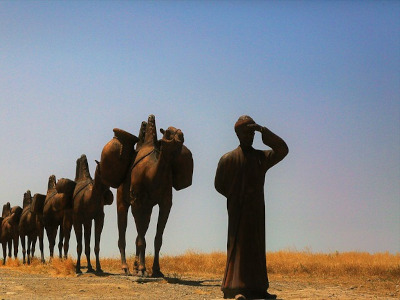The Silk Road is not an actual road or a single route. The Silk Road refers to different routes that were used by traders for over 1500 years, from 130 B.C.E. until 1453 C.E. The road was opened by the Han dynasty of China and closed by the Ottoman Empire. The term ‘Silk Road’ was first used by German geographer and traveller Ferdinand von Richthofen. He used this term to describe the well-travelled route of goods between Europe and East Asia. The term is also used as a metaphor for the act of exchanging goods between different cultures. The term silk route is more commonly used, but some historians prefer to use the term ‘silk routes’ because it refers to different pathways. The length of the Silk Road was approximately 6437 kilometers. The route was really difficult because it included the Gobi Desert and the Pamir Mountains.
The Silk Road was in very poor condition, and often the traders were attacked by robbers. To protect themselves, the traders joined together. Since the road was really long, over time inns for the travelling merchants were opened. They were called caravanserais. There were only a few merchants who travelled the whole route, meaning that a lot of goods reached the end of the road in a different merchant’s hands.
After the development of sailing, travel from east to west became a lot safer. It also contributed to the maritime industry because, after the usage of ships, the ports started to grow. The ports also provided traders with vital facilities not only for trading and disembarking but also for taking fresh water, as one of the biggest threats to seafarers in the Middle Ages was the lack of accessible drinking water. But sailing resulted in becoming prone to another danger to them, it was the pirates, who also wanted their part of the attractive goods.
As already said, the Silk Road consisted of many roads. The Silk Road is divided into two main roads, the northern and southern routes. The northern route started in Chang’an, which used to be the capital of China. The northern route was also split many times. The route went through the Taklamakan Desert, the Tian Shan Mountains, the Karakum Desert, and a lot of different valleys. All the routes joined the main southern route in Merv, Turkmenistan. The southern route was mainly one road. It started in China and went through the Karakoram Mountains. It also passed through northern Pakistan and Afghanistan, and it connected to the northern route in Merv. There was also a southwestern route and a maritime route.
A lot of different goods were transported on the Silk Road. The name of the road also comes from the popularity of Chinese silk. People in the west really loved the silk. They used it to dress the royals, and especially in Rome, they loved it a lot. The road also included India, Asia Minor, up throughout Mesopotamia, to Egypt, the African continent, Greece, Rome, and Britain. The closest partner in trading with China was the northern Mesopotamian region (Iran). They traded Chinese paper, which was invented by the Han Dynasty, and they also traded gunpowder with them. Also a very important good from the east were the spices, maybe even more important than the silk. From west to east, the goods that were traded were: horses, honey, fruits, camels, slaves, grapes and grapevine, textiles, etc. From the east to the west, as already said, the main goods were silk, spices, and gunpowder. But they also traded tea, dyes, precious stones, porcelain, perfumes, rice, etc.
In conclusion, the legacy of the Silk Road stands in cultural interaction because, in the process of trading, a lot of different nationalities were involved. The Silk Road was also used by travellers and explorers to better understand the Far East. The most famous of them might be Marco Polo, who used this route to travel from Italy to China. The Silk Road became one of the driving forces that influenced the development of various societies throughout Eurasia and beyond.

Sources:
https://education.nationalgeographic.org/resource/silk-road/
https://www.worldhistory.org/Silk_Road/
https://en.unesco.org/silkroad/about-silk-roads
https://en.wikipedia.org/wiki/Silk_Road
https://www.history.com/topics/ancient-middle-east/silk-road#silk-road-spices
